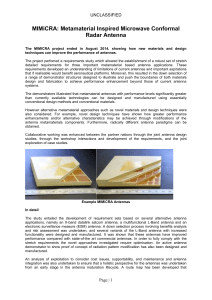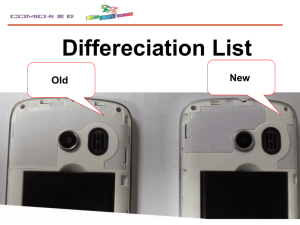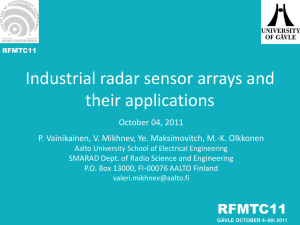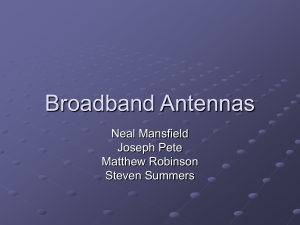App Note
advertisement
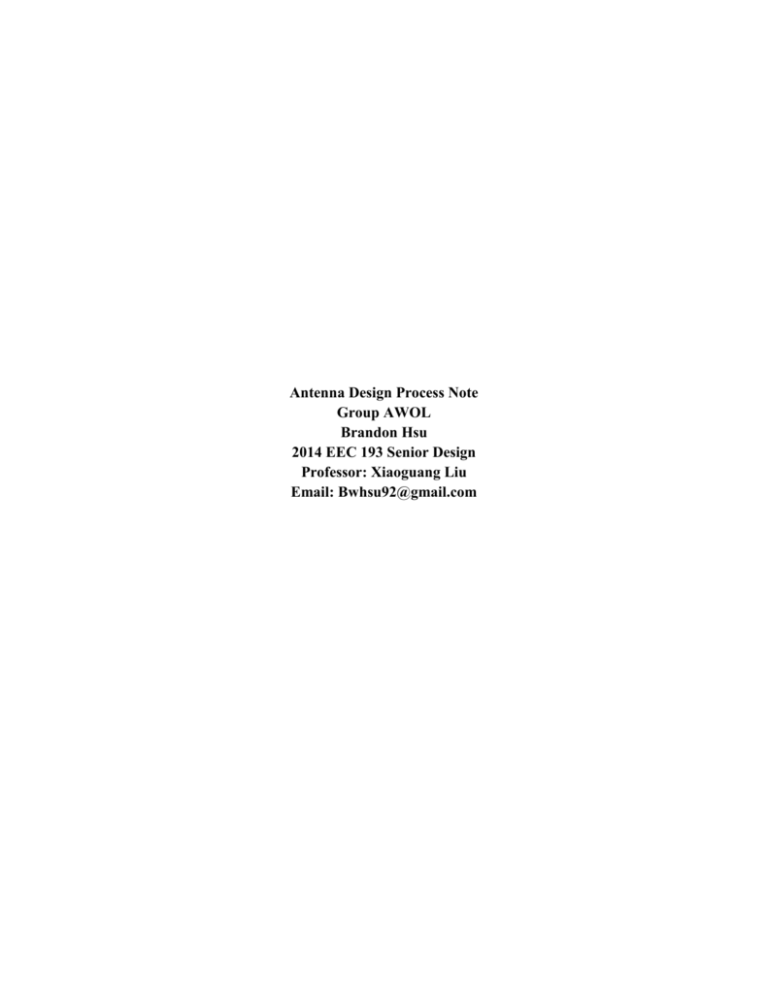
Antenna Design Process Note Group AWOL Brandon Hsu 2014 EEC 193 Senior Design Professor: Xiaoguang Liu Email: Bwhsu92@gmail.com Overview This application note will discuss general antenna design and important parameters of antennas. Mainly, the note will focus on an example of design process with patch Bow Tie Antenna using Agilent Technologies EMPro 3D Simulation Software, specifically used for project AWOL. Project AWOL, a wireless object locator, aimed to help locate loss objects through sound detection. A patch microstrip antenna was required to meet specifications of compactness and size and a bowtie Antenna design was selected low directivity, compact form factor, manufacturability, and acceptable performance for this application. Antenna Design Parameters Important parameters associate with antennas include directivity, gain, radiation pattern, return loss (S11), and aperture. More details and other important concepts of antennas such as solid beam angle, polarization, and half-power beamwidth can be found in Antenna handbooks or textbooks. Antenna Theory Analysis and Design by Constantine A. Balanis was used for reference in this note and the antenna design. The selected important parameters mentioned will be discussed. Useful terms and formulas will be provided in Appendix section. Directivity Directivity of an antenna is a measure of how directive the beam, radiation of electromagnetic waves, is radiating relative to an isotropic omni-directional antenna. An isotropic omni-directional antenna has a directivity of 1dBi and looks like a sphere in 3D. Isotropic means uniform radiation in all direction. From this, directivity D is always defined as D ≥ 1 and the units for directivity is dBi, decibel isotropic which is a scale referenced to isotropic antenna of 1 dBi. Directivity does not measure loss, gain,or power. It is only a measure of the direction where power is radiating. For example, a linear dipole antenna has low directivity and its radiation pattern is closer to the ideal isotropic antenna. The 3D model and Directivity is shown below. Figure1. Dipole Antenna with feed at gap Figure2. Directivity and Radiation Pattern of Linear Dipole Antenna The numbers are not visible but directivity of this antenna is about 1.7 dBi. The directivity of 1.7 dBi made sense because the pattern looks close to a sphere but with a donut shape having nulls at top and bottom. Directivity is an important parameter associated with antennas as it would provide information and quick idea of the radiation pattern of an antenna. Gain Gain of an antenna is strongly tied to directivity of an antenna. Gain is given as G = εD where ε is the efficiency of the antenna and D is the directivity. Gain is a measure of how much power is radiated relative to the amount of input power. A gain of 1 would be Pout = Pin since the same amount of power was transmitted as input power. Positive gain usually means higher directivity and negative gain only indicate that not much power is radiated in the specific direction. Gain is a good indication of how efficiently power is being radiated from the antenna. Sometimes it is sufficient to show the gain of the antenna as it provides information on directivity as well if shown in 3D with radiation pattern. For example, the gain plot of the linear dipole antenna shown in figure1 would look exactly like figure2 but the numbers on the scale, in dBi, would display gain instead of directivity. An example is shown in the design process in figure 5. Aperture Aperture, usually stated as effective aperture, is the area of the antenna that can receive or transmit power. The aperture of an antenna limits the amount of power it can receive or transmit as physical dimension of the antenna need to be considered. Effective aperture is not easy to define as antenna structures become complicated. Return Loss (S11) S11, scattering parameter, is directly related to reflection coefficient Г which is a measure of how much power transmitted is going through and how much is reflected back to the feed port. Return loss is defined in dB and given as RL (dB) = 20log|Г| or RL (dB) = 10log (Pin / Pre). Return loss measured at feed port is a very important parameter because it provides information on how well the antenna is matched to the feed port or system. A return loss very close to 0dB indicates that reflection coefficient is approaching 1 and most of the power fed to the antenna is being reflected. Thus, very low (negative) return loss is desired for antennas to prevent power loss and good match. Generally, a -10dB S11 (Return Loss) bandwidth is specified for antennas. Depending on application, -10dB of return loss across the desired bandwidth may not be sufficient. Besides power loss, a good matching of 50Ω system to antenna is important because transmitted waves are usually high power and high power reflected waves back into the system may cause unwanted damage or stability issues. Feed A very important aspect of antenna design is how to feed the antenna. Many ways of feeds can be implemented such as microstrip transmission line feeds, coplanar feeds, coaxial cable probe feeds, and other types of feeds that are not as common. Once antenna structure is designed, the signals that want to be received or transmitted have to somehow reach the antenna from the system for a transmitter or vice versa for a receiver. Feeds will introduce losses and improper feeds will cause the antenna to behave differently than designed. For example, a microstrip 50Ω transmission line feed was used for the bow tie antenna and the return loss changed greatly so the dimension of the antenna had to be changed to achieve good return loss at desired bandwidth. Microstrip Bow Tie Antenna Design Example and Process With the general overview of important antenna design parameters, the antenna used for the senior design project will be discussed and serve as an example of how these parameters are relevant. Bow tie antenna was selected for design to meet application of the project because the project required a compact antenna, easy manufacturability, low directivity, and PCB mountable. The directivity of the antenna needed to be low and close to 1 if possible without sacrificing too much gain. For the bandwidth, a -10dB S11 bandwidth was needed from 2.35-2.GHz for the application. In addition, stacking of different layers was not allowed due to limitation of milling machine in lab room. More bow tie antenna references could be found in appendix. The final design specifications are displayed below. Design Specifications: Operating Frequency Range: 2.35-2.6 GHz (-10dB Return Loss Bandwidth) Center Frequency: ~2.4GHz Gain: 2-3 dBi with Directivity of a donut shape Substrate: Rogers R3003 H = 20mil T = 1.5mil εr = 3.0 TanD = 0.0013 at f = 10GHz Size: Limited to size of half an iPhone, approximately 30 mm by 60 mm Design Process The process shown below is a good rule of thumb to follow for antenna design. Step 1. Determine Operating Frequency Prior to starting any design, an operating frequency and bandwidth must be specified for the antenna. For project AWOL, a frequency range of 2.3-2.6GHz was required. A good rule of thumb is to have -10dB S11 across the operating frequency range. Thus, the -10dB S11 bandwidth would be determined as 2.3-2.6GHz in this case. Step 2. Determine Antenna Type Once frequency range is determined, antenna type needs to be selected. Choosing antenna type is important because this determines the radiation pattern, directivity, desired for the application. In addition, directivity, as stated previously, directly relates to gain of the antenna. For example, an omni-directional pattern with low directivity antenna was desired for AWOL project. Through research in Antenna handbooks and texts, a bowtie Antenna was selected for compact form factor, manufacturability, and low directivity radiation pattern with good bandwidth. Step 3. Preliminary Design The dimensions of the selected antenna type should be calculated for first design. Generally, dipole-like antennas such as bow tie antenna should be about half-wavelength long. For microstrip antenna in this case, the waves are traveling in dielectric along the feed line before it radiates at the bow tie fans. Therefore, effective dielectric constant needs to be considered. A good quick approximation would be λ = c/(f*sqrt(εr)) since c (speed of light) = 1/sqrt(u*ε) where u is permeability constant and ε is permittivity constant. To be more precise, effective dielectric constant εeff should be used, but εr is sufficient for first preliminary design. Using this concept, the antenna length from one triangle base to the other was approximated to be 72mm using center frequency of 2.4GHz and εr of 3.0. Note that the final dimension was about 40mm long only because εeff was about 2 and not 3. Also, a good practice is to repeat step 4 and 5 for each part of the antenna individually before putting the antenna and feed lines together. For example, for first design, the port feed can be defined right at the bow tie antenna fans first to analyze the antenna input impedance and return loss. Then, feed lines can be added for simulation. Usually, the feeds would affect the antenna performance. With experience and observation from previous simulations when parts were isolated, time can be saved when optimizing because a better idea on what dimension to change should have been obtained. Step 4. Create 3D Model in 3D Simulation Software Simulation software such as CST, HFSS, or EMPro could be used. For this project, EMPro from Agilent Technologies will be used since the software license is available. Tutorials for different software can be found online. The images shown below are the bow tie antenna final design 3D model. Figure3. Bottom plane (left) and Top Plane (right) Step 5. Run Simulation of Designed Antenna Although 3D simulation software differs in drawing and definition mechanics, the setups needed for simulations are the same. Once models are drawn, materials need to be defined and assigned to each geometrical shape. For this project, the top and bottom plane are defined as copper and substrate defined accordingly to Rogers R3003 data sheet. Then, port with feed need to be defined for S-parameter simulation. One common problem with port definition is FEM padding. The port must be at the edge of simulation boundary box to prevent errors. Another difference between these software is that sometimes an air box needs to be drawn for accurate simulation. In addition, for symmetrical antenna structures, it is best to draw the model such that symmetry is preserved across the origin as shown in Figure3 for accurate simulation results. The S11 simulation result from EMPro is shown below for example. The S11 response from simulation met the required -10dB S11 bandwidth, but a good design should aim for -15dB across the desired bandwidth to account for losses from non-ideal effects. Some real world effects that could introduce loss could be dielectric loss, rough edges of the microstrip, solder parasitics from mounting the connectors, and manufacture tolerance that may cause the fabricated antenna dimension to be off slightly. Also, the specified dielectric constant, thickness of substrate, and copper cladding are not always the same. The tolerance and deviation can be found on data sheets. Besides S11, directivity and gain should also be looked at. Figure 5 shows the gain of the bowtie antenna. The max gain was about 7dBi and the radiation pattern was not strictly omni-directional like a donut shape. However, as stated in step 7, accurate results of radiation pattern can only be obtained using anechoic chamber to compare with simulated results. Figure4. S11 Response from EMPro Simulation Figure 5. Gain and Radiation of Bow Tie Antenna Step 6. Optimization of Design Most of the time, the first design will not be desirable and will not meet the requirements. Sometimes optimizations through tuning of antenna dimensions are needed. A good simulation result to look at when tuning the design is S11 and input impedance. The input impedance across the desired bandwidth should be close to 50Ω to have a good match and low S11. Also, looking at input impedance plots could give a better idea of how to tune the design and if the antenna is resonating at the designed frequency. An input impedance plot is shown in figure5 from the same simulation. Comparing input impedance and S11 plots serves as a good sanity check. For this example, the input impedance across the 2.3-2.6GHz frequency band appears to be fairly close to 50Ω with imaginary part staying close to 0. By looking at how input impedance plot changes between each tune, a better sense of approaching optimization can be obtained. Figure 6. Input Impedance of Bow Tie Antenna Step 7. Exporting File for Fabrication Once satisfied with simulation results and final designs are ready, the 3D CAD, computer-aided-design, model needs to be exported to file types recognized by the milling machines. Many fabrication companies or milling machines in the university requires file types such as Gerber or DXF for fabrication. Gerber or DXF files are basically 2D layer files that contain the outline of 3D model. Once exported correctly, the information carried in Gerber or DXF file would tell the milling machine which geometrical shape is for which layer. For example, the exported Gerber files for bow tie antenna design contained three files. One file for top layer, one file for substrate, and one file for bottom layer. Step 8. Testing the Fabricated Antenna Connectors should be soldered on to the fabricated antenna for testing with spectrum analyzer and network analyzer. Figure 6 shown below is two fabricated copies of final bow tie antennas with connectors soldered. Figure 7. Fabricated Bow Tie Antennas Top Side (left) and Bottom Side (right) The antennas are hooked up to network analyzer to measure the S11 response of the antennas. Left and right images are S11 responses shown respectively to fabricated antennas in figure 6. The numbers on the monitors are hard to see, but the final tested response gave -10dB S11 bandwidth of 2.35-2.7GHz. Figure 8. S11 Measurement with Network Analyzer To obtain measured results of radiation pattern and gain, anechoic chamber is required. For this project, the anechoic chamber was not available for use so rough gain calculations were made as well as a rough radiation pattern. To calculate the antenna gain, friis transmission formula could be used as shown below. Pr = Pt + Gr + Gt + 20 log(wavelength/4*pi*R) Pr is power received, Pt is power transmitted, Gr is gain of receiver antenna, Gt is gain of transmitter antenna, and R is distance away. To start off, the antennas were spaced about 2 meters apart, precisely 2.334 meters, and the gains of both antenna are assumed identical Gt = Gr. Wavelength used was 0.125 meters (2.4GHz as center frequency). Coaxial cable attenuation loss were measured and factored into account and the total cable loss summed up to be about 10dB. Gt = Gr -> Pr = Pt + 2G + 20log(0.125m/4*pi*2.334m) 20log(0.125/4*pi*2.334) = -47.33dBm The RF signal generator had power output set to 0dBm, Pt = 0dBm, and the Pr received on spectrum analyzer was -52dBm, Pr = -52dBm. 2G = Pr - Pt + 47.33dBm + 10dBm (Cable loss) 2G = 5.55 G = 2.75 dBi From this calculation, the gain of each antenna was about 2.75 dBi. However, the rough calculation is not good enough for antenna characterization. It is best to ask for access to anechoic chambers for precise measurement of antenna. Summary The fundamental antenna parameters and general steps for designing an antenna were discussed in this note. Some precautions were also introduced. The fabricated antenna will have real world loss, so the -10dB S11 bandwidth should be designed to be -15dB bandwidth if possible. For substrate selection, higher relative dielectric constant would reduce size but the propagation of the waves would be slower. In addition, substrates with thickness of 60 mil should be selected for easier milling. If anechoic chamber access is not available, a method for approximating gain of the antenna was shown. Appendix Useful terms and formula: CAD Software – Computer-Aided-Design Software 3D EM Simulation Software – Agilent Technologies EMPro, HFSS, Microwave Studio CST DXF – Drawing Exchange Format (AutoCad), the file extension format that is commonly used for CAD Software and for milling machine Gerber – Gerber drill files are files that contain information for each layer of the microwave integrated circuit. It could be filters, microstrip antennas, or other structures. Gerber files are commonly used for fabrication and milling machines. Feed – Feeds can be microstrip transmission lines, coaxial cable probes, or other structures that feed the antenna with signal to radiate or it leads the signal to your system for received signals. Directivity - Measure of how directive the antenna is radiating power. Isotropic Omni-Directional antenna has D=1 Gain - G = εD where ε is efficiency (not 100% due to mismatch and reflections) of the antenna and D is directivity. Aperture – Physical area where the antenna can receive or transmit power. This limits the maximum power that can be received or transmitted by an antenna. Return loss - RL = 20log(|Г|) where Гis reflection coefficient or RL = 10log(Pin/Preceive). It's a measure of how much loss at input port and how much power is reflected. Friis Transmission Equation - Pr = Pt + Gr + Gt + 20 log(wavelength/4*pi*R), units must be in dB Non-dB form: Pr = Pt * Gr * Gt * (wavelength/4*pi*R)^2 Note* R >> λ for this equation to be valid. R < λ , the equation is invalid. Gt – Gain of transmitter antenna Gr – Gain of receiver antenna Pt – Power transmitted to the transmitter antenna Pr – Power received after the receiver antenna R – Distance between transmitter and receiver antenna Substrates: H – Thickness of substrate T – Copper cladding thickness εr – Relative Dielectric (Permittivity) constant of substrate. SA – Spectrum Analyzer VNA (NA) – Vector Network Analyzer or Network Analyzer Useful Resources http://www.antenna-theory.com/antennas/wideband/bowtie.php - for bowtie antenna basic theory Antenna Theory Analysis and Design by Constantine A. Balanis Antenna Engineering Handbook by John Volakis Compact and Broadband Microstrip Antennas by Kin-Lu Wong

